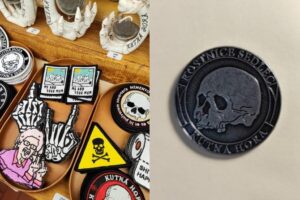Sedlec Ossuary – Bone church of Kutná Hora | by Sasha
Situated in the region of Central Bohemia, east of Prague, about 70 kilometers away, is a small town by the name of Kutná Hora. The name of this place (according to most sources) comes from the word “kutat” which means “to mine” and “hora” which means “mountain”. It’s an absolutely stunning medieval gem, nesting on a crown that is the lush nature surrounding it. It’s a medieval, frozen landscape of times depicted in history books: cobblestone streets, small baroque terraced houses, sublime displays of gothic architecture – the church of St. Barbara and the Cathedral of Our Lady at Sedlec, a whole mysterious stone fountain that sits in the center of the town, presenting as nothing more but a relic of the past…
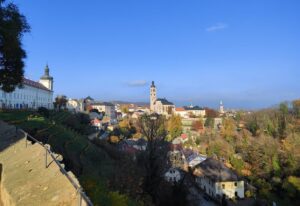
But aside from these unforgettable vistas, what usually attracts tourists to this lovely place is quite bizarre and you might have heard of it too. Across the street from the Cathedral of Our Lady at Sedlec, is a building that houses morbid display of cruelty of the medieval age – Sedlec Ossuary sits surrounded by graves of dearly departed, nothing more than a very regular cemetery. However, behind those big wooden doors is an unusual resting (or more like un-resting) place. Once you cross that part and you will find yourself inside the macabre and unusual Church of Bones.
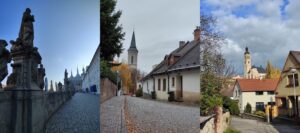
Hello everybody, my name is Sasha. Keeping up with my interest of things that are ghoulish, nightmarish, or sometimes downright wicked, I came across the very famous Czech “Bone Church” and couldn’t believe my own eyes and ears. The whole concept seemed so outlandish to me – what does one mean when they say there is a church that is “decorated with human skulls and bones”? I thought to myself that this can’t be real and is probably a tourist trap, however many people recommended me to see it, so I’ve had to check it out. Months later, the chance to do exactly that would arise when I and my friend decided to go to the small and pretty town of Kutná Hora. Going back to the etymology of the settlement: the mining association in the name derives from the fact that it used to be a royal city due to its very useful silver mining ventures. It actually used to be the second largest Czech city in its prime! Boasting about 80,000 inhabitants. Reaching such a stature granted the town beautiful and impressive churches and cathedrals that are now considered UNESCO heritage sites. The entire city is very beautiful, the layout, the nature, the buildings… I’m of course biased towards cities that have terraces and levels, but you can look at some of the pictures included in this blog and judge for yourself. You can also peek the haunting vistas of Kutná Hora if you’re taking the railway which goes right next to Vrchlice river. The sight of Breuer gardens and the façade of St. Barbara’s Cathedral is burnt in my memories forever. It almost feels like it was artificially set up to look this way. The best comparison I can make to this – which will sound incredibly nerdy – it feels like traversing an alive world of Dark Souls, for those who know, will understand.
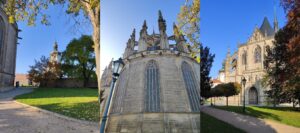
On our third day of stay, we decided to go to the side of the town we haven’t visited yet. The Cathedral of Our Lady at Sedlec is located on the suburban area of Kutná Hora, so the walk there doesn’t comprise of sights you haven’t seen before, quite the ordinary. If you get a chance to visit the cathedral, I recommend, it’s quite captivating with its remains of saints and other members of the clergy (foreshadowing). When you come outside of the church and walk down the road to the north, you will find a small church surrounded by thick, white walls. On the inside, is a garden full of decorated and graves that are taken care of well. I unfortunately couldn’t find any information about the significance of these graves and I think it’s just working as a cemetery for local clergy members or notable personas.
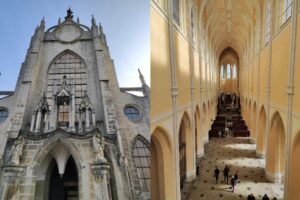
The inside of the chape is where the mystery really dwells. I remember opening the doors and walking down the stairs to be welcomed by a macabre scene, just like what I’ve seen in the pictures. I remember feeling a little bit disappointed when I looked around and saw that the whole place was just one room and nothing more, even though online it looked like the exhibition spanned across multiple rooms. With grim fascination I walked over to the décor made of bones and remember thinking “this is so absurd and almost cartoonish, it can’t be real, right?”. But let me assure you, when I looked at the skulls, I noticed that they were not replicas of each other: they had different characteristics and features like real human skulls would have. Upon realizing that, my hair stood still and I froze in place. It’s one thing to see it through pictures and it’s a whole different level of unsettling and disturbing when you’re getting stared down by thousands and thousands hollow of eyes of the dead, wrangled into decorating chandeliers, wall frames, painting frames and other elements of the entire design… I was in shock trying to understand what madness could have driven someone to make such a sinister display.
To answer that, let’s go over the history of the chapel itself: before it became the silver-rich city, Kutná Hora was just “The Church of All Saints and Ossuary”, the first Cistercian monastery which doesn´t exist anymore. Order of Cisterians, for those who don’t know, are a branch of Catholic Christians that follow the Rule of Saint Benedict. The lands around the monastery were burial grounds, especially popular after the story that the Cisterian abbot was sent to Jerusalem, who came back with a jar of dirt from Golgotha and sprinkled the “Holy Soil” all over the grounds. Another source says the abbot came back with Akeldama clay and used that to bless those who have passed. Golgotha is the site where Jesus was crucified and Akeldama is a piece of land in Jerusalem which was bought by Judas, the one who betrayed Jesus for 30 pieces of silver. Other sources suggest both of these are just rumors and were used to popularize the gravesite. After the silver mines were established in 13th century and Kutná Hora became Kutná Hora the royal city, a lot more people were dying there, especially due to Bohemian Wars (Hussite Wars), famine and the Black Death plague. So, mass graves started filling up on the site of the chapel. Fast forward a few centuries, in 19th century the Ossuary and its land was sold off to the Schwarzenberg family and they commissioned a Czech carpenter and a carver František Rint to help with the reconstruction of the place. In 1870, skeletons under the church were exhumed and were used in decorating the interior: chandeliers, garlands, monstrances, frames and of course – the Schwarzenberg family coat of arms, made entirely out of these bleached and cleaned human bones and skeletal remains. Staring at these morbid decorations, me and my friend were both freaked out, but the most normal and acceptable piece were the skull pyramids. I think I’m so used to the catacombs that it felt like watching another mass grave of bones. However, I’m pretty sure those who’ve visited the catacombs and experienced looking at cadavers in the walls that close would have been disturbed in the same fashion as I described.
All and all, my thoughts are that since taking pictures inside have been forbidden since 2020, the promotional pictures online are a little bit deceiving in the scale part, on the horror part – it’s absolutely real and it can crawl under your skin. My friend had to leave the church early, they said the aura was very unpleasant, can’t blame them at all. If you ever get the chance to travel to Kutná Hora, you absolutely should, it’s a lovely town and the cake bakeries there are top notch. There are plenty of sights inside the city of silver, as well as on the outside, in the beautiful nature trails surrounding it. If you’re there and are into bizarre things like me, then you should probably check out the Sedlec Ossuary, it’s a once in a lifetime experience. However, I do have to note the giftshop was very cool! I still cherish my fridge magnet, my Memento Mori coin and the skull dice I bought. The souvenirs there ranged from simple things like that to huge gothic decorated chalices with skulls and detailed iron figures. That’s it for the infamous Sedlec Ossuary, or as people know it “The Bone Church”. I’ll catch you guys another time, in the meantime, stay unsettling and stay curious, čau!
